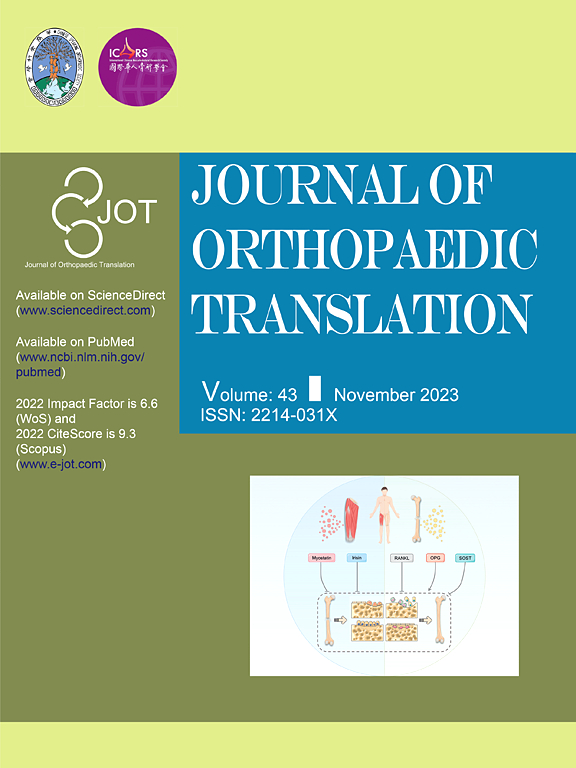Dihydroartemisinin ameliorates hemarthrosis-induced cartilage degeneration by suppressing chondrocyte senescence via activation of Keap1-Nrf2 signaling pathway
IF 5.9
1区 医学
Q1 ORTHOPEDICS
引用次数: 0
Abstract
Background
Joint bleeding (hemarthrosis) is a major manifestation of joint trauma, especially repeated and spontaneous in hemophilia patients. Hemarthrosis has been identified to induce the excessive reactive oxygen species (ROS) accumulation and permanent damage in articular cartilage. Dihydroartemisinin (DHA), a well-known clinical anti-malaria drug with few sides effects therapy, has been reported to possess anti-oxidative activity. This study was aimed at exploring the effect of DHA on blood-induced cartilage erosion and its underlying mechanisms.
Methods
Two distinct hemarthrosis models were constructed respectively by fresh blood joint injection in WT and joint needle puncture in F8−/− mice, and then treated with DHA (10 or 20 mg/kg/day) for 4 weeks. In vitro chondrocytes treated with frozen-thaw blood and DHA (1, 5 or 10 μM) for 24 h. Histopathological, immunofluorescence and western blotting were investigated to demonstrate the effects of DHA on blood-induced chondrocyte senescence, ROS accumulation and extracellular matrix (ECM) degradation. Additionally, Nrf2 inhibitor (MLB385, 30 mg/kg for once a four days) and Nrf2-siRNA were used to investigate the relationship between DHA and Nrf2/Keap1 signaling in vitro and in vivo, respectively.
Results
DHA remarkably ameliorated the cartilage degeneration in both two hemarthrosis models. Similarly, in vitro experiments confirmed that DHA promoted the synthesis of ECM in blood-stimulated chondrocytes with a dose-dependent manner. DHA also effectively suppressed blood-induced chondrocyte senescence and ROS accumulation. Mechanistically, DHA activated the Nrf2 signaling by accelerating Keap1 ubiquitination and degradation. Furthermore, Nrf2 siRNA and antagonist abolished the anti-senescence and anti-oxidative functions of DHA, resulting the severe cartilage degeneration in bleeding joint of F8−/− mice.
Conclusion
Our findings indicate that DHA effectively reduces chondrocyte senescence and mitigates cartilage destruction following hemarthrosis via activation of Nrf2/Keap1 signaling pathway.
The Translational potential of this article
On the one hand, this study highlights the important role of chondrocyte senescence in hemarthrosis-induced cartilage degradation, implying that inhibiting chondrocyte senescence may be a viable therapeutic strategy for blood-induced arthropathy. On the other hand, our findings demonstrate the remarkable chondroprotective effect of DHA in bleeding joint by modulating the Nrf2/Keap1 anti-oxidative signaling pathway, suggesting DHA may serve as a potential candidate drug for the therapy of blood-induced arthropathy.

双氢青蒿素通过激活Keap1-Nrf2信号通路抑制软骨细胞衰老,改善血关节病诱导的软骨变性
背景:关节出血(血肿)是关节创伤的主要表现,尤其是血友病患者反复发作和自发性出血。关节血肿已被确定可诱导过多的活性氧(ROS)积累和关节软骨的永久性损伤。双氢青蒿素(DHA)具有抗氧化活性,是临床公认的副作用小的抗疟疾药物。本研究旨在探讨DHA对血源性软骨侵蚀的影响及其潜在机制。方法采用WT小鼠鲜血关节注射法和F8 - / -小鼠关节针穿刺法分别建立2种不同类型的关节出血模型,然后分别给予DHA(10、20 mg/kg/d)治疗4周。以DHA(1、5或10 μM)和冻融血处理体外软骨细胞24 h,通过组织病理学、免疫荧光和western blotting观察DHA对血液诱导的软骨细胞衰老、ROS积累和细胞外基质(ECM)降解的影响。此外,采用Nrf2抑制剂(MLB385, 30 mg/kg, 1次/ 4 d)和Nrf2- sirna分别在体外和体内研究DHA与Nrf2/Keap1信号传导的关系。结果dha可显著改善两种血关节模型的软骨退变。同样,体外实验证实,DHA促进血液刺激软骨细胞中ECM的合成并呈剂量依赖性。DHA还能有效抑制血液诱导的软骨细胞衰老和ROS积累。在机制上,DHA通过加速Keap1泛素化和降解激活Nrf2信号。此外,Nrf2 siRNA和拮抗剂破坏DHA的抗衰老和抗氧化功能,导致F8−/−小鼠出血关节软骨严重退变。结论DHA通过激活Nrf2/Keap1信号通路,有效减缓关节血肿后软骨细胞衰老和软骨破坏。一方面,该研究强调了软骨细胞衰老在血液病诱导的软骨降解中的重要作用,这意味着抑制软骨细胞衰老可能是血液诱导的关节病的一种可行的治疗策略。另一方面,我们的研究结果表明DHA通过调节Nrf2/Keap1抗氧化信号通路在出血关节中具有显著的软骨保护作用,提示DHA可能作为治疗血源性关节病的潜在候选药物。
本文章由计算机程序翻译,如有差异,请以英文原文为准。
求助全文
约1分钟内获得全文
求助全文
来源期刊

Journal of Orthopaedic Translation
Medicine-Orthopedics and Sports Medicine
CiteScore
11.80
自引率
13.60%
发文量
91
审稿时长
29 days
期刊介绍:
The Journal of Orthopaedic Translation (JOT) is the official peer-reviewed, open access journal of the Chinese Speaking Orthopaedic Society (CSOS) and the International Chinese Musculoskeletal Research Society (ICMRS). It is published quarterly, in January, April, July and October, by Elsevier.
 求助内容:
求助内容: 应助结果提醒方式:
应助结果提醒方式:


